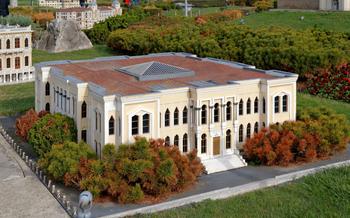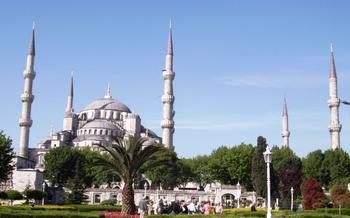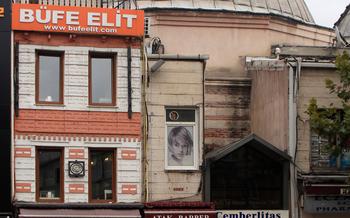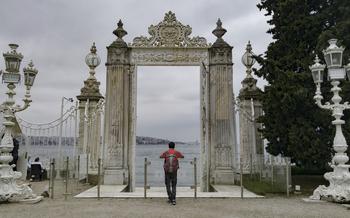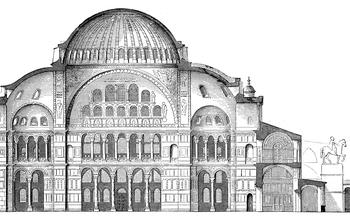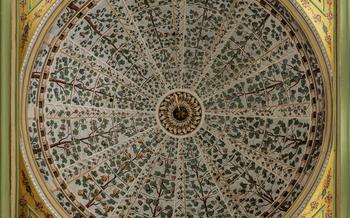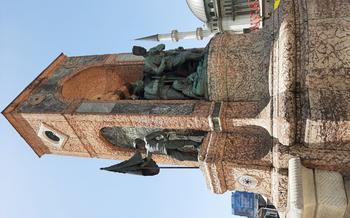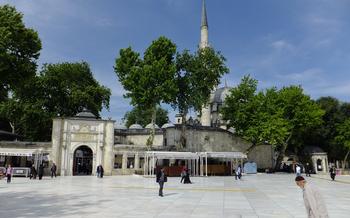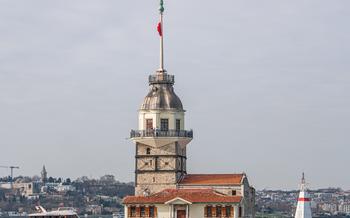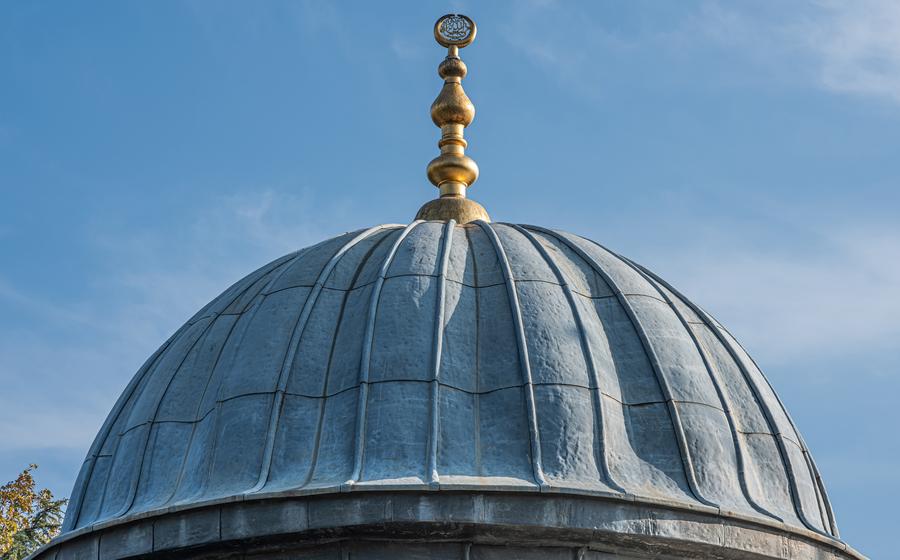
Aynalikavak Pavilion
- Aynalıkavak Pavilion: An Enchanting Gem in Istanbul's Heart
- Location and Accessibility
- Hours of Operation and Admission Fees
- Guided Tours and Audio Guides
- Exploring the Pavilion's Gardens
- Combining Your Visit with Other Attractions
- Photography and Videography Guidelines
- Accessibility for Visitors with Disabilities
- Family-Friendly Activities and Amenities
- Historical Context and Significance
- Visiting During Special Events
- Local Cuisine and Dining Options
- Shopping and Souvenirs
- Insider Tip: Hidden Gems and Secret Spots
Aynalıkavak Pavilion: An Enchanting Gem in Istanbul's Heart
Nestled amidst the vibrant tapestry of Istanbul's historic Topkapi Palace, the Aynalıkavak Pavilion stands as a testament to the grandeur and artistry of the Ottoman Empire. Built in the 17th century by Sultan Murad IV, this opulent pavilion served as a private retreat for the sultan and his court, hosting lavish ceremonies, celebrations, and diplomatic receptions.
Its historical significance extends beyond its role as a royal residence. The Aynalıkavak Pavilion played a crucial role in shaping the cultural and artistic landscape of the Ottoman Empire. It was here that the empire's elite gathered, fostering intellectual discourse, artistic expression, and the exchange of ideas. The pavilion's walls bear witness to the empire's rich history, showcasing the evolution of Ottoman art and architecture over centuries.
Architecturally, the Aynalıkavak Pavilion is a masterpiece of Ottoman design. Its elegant silhouette, intricate tilework, and graceful arches blend harmoniously to create a visually stunning structure. The pavilion's interior is equally captivating, adorned with breathtaking frescoes, calligraphy, and intricate mirrorwork that reflect the exquisite craftsmanship of the era.
Step into the stunning interior of the Aynalıkavak Pavilion, and prepare to be mesmerized by its opulent splendor. The Hall of Mirrors, with its shimmering walls and crystal chandeliers, exudes an ethereal glow that transports visitors to a magical realm. The Sultan's Chamber offers a glimpse into the private life of the Ottoman rulers, showcasing their opulent lifestyle and personal belongings. The Imperial Harem, a secluded section of the palace, unveils the intriguing stories of the sultan's family and concubines.
Location and Accessibility
The Aynalıkavak Pavilion is conveniently located in the heart of Istanbul, within the Topkapi Palace complex. Its exact address is:
Aynalıkavak Kasrı, Bab-ı Hümâyun Caddesi, 34122 Fatih/İstanbul
Visitors can easily reach the pavilion via various transportation options. The closest tram stop is Gülhane, which is a short walk from the palace entrance. Alternatively, visitors can take the T1 tram line and get off at the Sultanahmet stop, followed by a scenic walk through the historic Sultanahmet district.
For those arriving by car, there are limited parking spaces available near the palace. However, it's recommended to use public transportation or taxis to avoid the hassle of finding parking.
The Aynalıkavak Pavilion is situated within walking distance of other popular tourist attractions in Istanbul, such as the Topkapi Palace, the Hagia Sophia, and the Blue Mosque. Visitors can easily explore these landmarks on foot, creating a comprehensive itinerary for their day in the historic center of Istanbul.
Hours of Operation and Admission Fees
The Aynalıkavak Pavilion welcomes visitors on all days of the week, except Mondays, from 9:00 AM to 5:00 PM. Plan your visit accordingly to avoid disappointment.
Admission fees are applicable for both local and international visitors. For local visitors, the entrance fee is [amount in TRY], while international visitors pay an admission fee of [amount in USD/EUR].
Students, seniors, and holders of certain cultural heritage cards may be eligible for discounted rates. Please inquire at the ticket counter for more information.
To avoid the crowds and enjoy a more serene experience, consider visiting the pavilion during off-peak hours or on weekdays. This will allow you to explore the pavilion's intricacies at a leisurely pace and capture stunning photographs without the hustle and bustle.
Guided Tours and Audio Guides
Enhance your visit to the Aynalıkavak Pavilion by opting for a guided tour or immersing yourself in the self-guided audio tour experience. Guided tours are available in multiple languages, providing insightful narratives and anecdotes that bring the pavilion's history and significance to life. The knowledgeable guides will lead you through the opulent halls and chambers, sharing captivating stories and ensuring you don't miss any hidden gems.
For a more independent exploration, the audio guides offer a comprehensive commentary in various languages. Listen at your own pace as you wander through the pavilion, delving into the rich history and cultural significance of each exhibit. The audio guides are particularly useful for those who prefer a personalized and self-paced experience.
To make the most of your visit, consider joining a guided tour for an in-depth understanding of the pavilion's highlights. For those who prefer a more flexible approach, the audio guides provide a convenient and informative alternative. Whichever option you choose, you'll gain a deeper appreciation for the Aynalıkavak Pavilion's architectural marvels and historical significance.
Exploring the Pavilion's Gardens
Strolling through the landscaped gardens surrounding the Aynalıkavak Pavilion is a delightful experience that offers a serene respite from the bustling city. These gardens, meticulously designed to complement the architectural beauty of the pavilion, provide visitors with a tranquil oasis to relax and admire the natural wonders.
As you wander through the gardens, you'll encounter a variety of colorful flowers, lush greenery, and towering trees that create a vibrant tapestry of colors and textures. Take a moment to pause and appreciate the intricate details of the garden's design, from the carefully placed fountains and sculptures to the meandering pathways that invite exploration.
Among the highlights of the gardens is a hidden gem known as the Secret Garden. Tucked away from the main paths, this secluded spot offers a tranquil retreat where visitors can escape the crowds and immerse themselves in the beauty of nature. Surrounded by fragrant flowers and the gentle sound of trickling water, the Secret Garden is the perfect place to relax and find inner peace.
The gardens of the Aynalıkavak Pavilion also offer a unique perspective on the changing seasons. In spring, the air is filled with the sweet scent of blooming flowers, while summer brings a vibrant explosion of colors as the gardens come alive with lush greenery. Autumn transforms the landscape into a breathtaking display of golden hues, and winter brings a serene stillness as the gardens rest under a blanket of snow.
To capture the best photos of the gardens, it's recommended to visit during the golden hours of sunrise or sunset when the light casts a warm glow on the surroundings. Experiment with different angles and perspectives to capture the essence of the gardens' beauty, whether it's a wide shot showcasing the panoramic view or a close-up highlighting the intricate details of a flower.
Combining Your Visit with Other Attractions
A visit to the Aynalıkavak Pavilion can be easily combined with other nearby attractions, allowing you to create a comprehensive and fulfilling itinerary. The pavilion is situated in the heart of Istanbul's historical peninsula, within walking distance of several iconic landmarks. Explore the magnificent Topkapi Palace, the former residence of Ottoman sultans, and delve into its rich history and architectural wonders. Stroll through the vibrant Grand Bazaar, one of the oldest and largest covered markets in the world, where you can haggle for unique souvenirs and experience the bustling atmosphere of traditional Turkish commerce. Visit the Hagia Sophia, a architectural masterpiece that has served as a church, a mosque, and now a museum, and admire its awe-inspiring dome and intricate mosaics. Combine history, culture, and shopping in one unforgettable day in Istanbul.
Photography and Videography Guidelines
Photography and videography are permitted within the Aynalıkavak Pavilion, subject to specific guidelines and restrictions.
Photography is allowed for personal, non-commercial use only. Tripods and flash photography are prohibited to preserve the integrity of the artifacts and ensure a serene environment for all visitors. Visitors are kindly requested to be respectful of other guests and avoid causing disruption during their visit.
To capture the best shots, consider using a wide-angle lens to capture the grandeur of the halls and gardens. Experiment with different angles and perspectives to create unique and captivating compositions. Remember to adjust your camera settings according to the lighting conditions to achieve optimal results.
Accessibility for Visitors with Disabilities
The Aynalıkavak Pavilion is committed to ensuring an inclusive and accessible experience for all visitors, regardless of their abilities. Wheelchair users and visitors with limited mobility will find the pavilion fully accessible, with ramps and elevators providing easy access to all levels of the building. Designated parking spaces are available near the entrance for visitors with disabilities, and the staff is always happy to assist with any special needs or requests. Assisted tours are available upon request, providing a personalized and inclusive experience for visitors with disabilities. To ensure a smooth and enjoyable visit, visitors with disabilities are encouraged to contact the pavilion in advance to discuss any specific requirements or assistance needed.
Family-Friendly Activities and Amenities
The Aynalıkavak Pavilion offers a range of activities and amenities that cater to families with children. The pavilion's interactive exhibits and displays, such as touchscreens and multimedia presentations, are designed to engage and educate young visitors. In addition, the pavilion hosts occasional children's programs and workshops, providing hands-on activities and storytelling sessions that bring history to life for kids.
Families can take advantage of stroller parking areas and changing tables located throughout the pavilion. Dedicated family areas provide a comfortable space for parents to relax and feed their children. To keep children engaged throughout the visit, consider bringing along activity books, snacks, or small toys to entertain them during breaks.
With its engaging exhibits, interactive activities, and family-friendly amenities, the Aynalıkavak Pavilion offers a memorable and educational experience for visitors of all ages.
Historical Context and Significance
The Aynalıkavak Pavilion stands as a testament to the grandeur and legacy of the Ottoman Empire. Built during the reign of Sultan Ahmed I in the early 17th century, it served as a pleasure palace and a venue for lavish receptions and ceremonies. The pavilion's design reflects a blend of Ottoman and European architectural influences, showcasing the empire's openness to cultural exchange and its position as a crossroads of civilizations. Throughout its history, the Aynalıkavak Pavilion has played a significant role in diplomatic negotiations, hosting foreign dignitaries and envoys from across the globe. Its opulent interiors and exquisite gardens were designed to impress and awe visitors, demonstrating the wealth and power of the Ottoman Empire. Today, the pavilion stands as a living museum, inviting visitors to step back in time and experience the splendor of one of the world's most influential empires.
Visiting During Special Events
The Aynalıkavak Pavilion comes alive during special events, offering visitors a chance to experience its historical significance and cultural heritage in a unique way. One of the highlights is the annual Turkish Music Festival, held in the pavilion's idyllic gardens during the summer months. This festival showcases the rich diversity of Turkish music, from traditional Sufi melodies to contemporary compositions, performed by renowned artists in an enchanting setting.
For a truly immersive experience, plan your visit to coincide with the Ottoman Palace Feast. This special event takes place on select evenings and transports visitors back in time to the era of the Ottoman Empire. Guests are treated to a lavish feast prepared according to traditional recipes, accompanied by live music, dance performances, and storytelling.
During the holy month of Ramadan, the pavilion takes on a special ambiance. The gardens are adorned with twinkling lights, and the air is filled with the sounds of traditional devotional music. Visitors can break their fast with a traditional Turkish iftar (evening meal) at one of the nearby restaurants, offering a unique opportunity to experience the local culture and traditions.
To make the most of your visit during special events, plan ahead and book your tickets in advance, especially for popular events like the Turkish Music Festival. Dress appropriately for the occasion, and be mindful of local customs and traditions. With its captivating atmosphere and rich cultural offerings, the Aynalıkavak Pavilion promises an unforgettable experience during special events.
Local Cuisine and Dining Options
After exploring the Aynalıkavak Pavilion's rich history and architectural beauty, visitors can indulge in the culinary delights of Turkish cuisine at nearby restaurants and cafes. The area offers a diverse range of dining options, from traditional Turkish fare to international cuisine.
To savor the authentic flavors of Turkish cuisine, try traditional dishes like kebabs, pide, lahmacun, and gözleme. These dishes are widely available in restaurants and street food stalls throughout the area. Don't miss the opportunity to sample Turkish delights, a sweet treat made from a combination of nuts, fruits, and spices, often accompanied by Turkish coffee.
For vegetarians and vegans, there are plenty of options to choose from. Many restaurants offer delicious vegetable dishes, such as stuffed eggplant, lentil soup, and falafel. Fresh salads, mezzes, and dips provide a variety of flavors and textures to complement your meal.
To find the best local food, venture off the beaten path and explore the side streets and alleys near the Aynalıkavak Pavilion. This is where you'll find hidden gems serving traditional Turkish dishes at affordable prices. Don't be afraid to ask locals for recommendations or try street food, which often offers a taste of authentic Turkish cuisine.
Remember to embrace the local culture and customs when dining in Turkey. Be prepared to bargain at local shops and markets, as it's a common practice. This not only allows you to get a fair price but also shows respect for local traditions.
Shopping and Souvenirs
After exploring the Aynalıkavak Pavilion, indulge in a delightful shopping experience in the nearby streets and bazaars. Discover unique souvenirs and local handicrafts that capture the essence of Turkish culture. From intricate carpets and colorful ceramics to exquisite jewelry and traditional textiles, there's something for every taste and budget. Bargaining is a common practice in local shops, so don't hesitate to engage in friendly negotiations to get the best prices.
For a truly authentic experience, venture into the side streets and explore the hidden gems of local artisans. You'll find handmade pottery, intricate woodwork, and shimmering copperware that showcase the skills and creativity of local craftsmen. Remember to ask about the stories behind the products, as each piece often carries a unique tale of its own.
To find truly unique souvenirs, look for items that are handcrafted and locally made. Support the local economy and preserve cultural traditions by purchasing these treasures. Whether it's a hand-painted ceramic plate, a vibrant Turkish scarf, or a beautifully woven rug, your souvenir will serve as a lasting reminder of your visit to the Aynalıkavak Pavilion and the vibrant city of Istanbul.
Insider Tip: Hidden Gems and Secret Spots
Beyond the well-known attractions, the Aynalıkavak Pavilion holds hidden gems and secret spots that offer a unique and immersive experience for visitors. One such gem is the secluded garden, nestled amidst the pavilion's lush greenery. This tranquil oasis provides a serene escape from the bustling city, allowing visitors to relax and soak in the beauty of nature.
For breathtaking panoramic views, venture to the rooftop terrace, which offers unparalleled vistas of the pavilion, the surrounding gardens, and the vibrant cityscape beyond. This hidden gem is a perfect spot to capture stunning photographs and create lasting memories.
Photography enthusiasts will delight in the plethora of unique angles and compositions found within the pavilion and its grounds. From intricate details of architectural elements to captivating reflections in the Hall of Mirrors, there are endless opportunities to capture the essence of this extraordinary place.
To delve deeper into the local culture, seek out nearby hidden gems recommended by locals. These lesser-known spots, often frequented by residents, offer a more authentic and immersive experience, allowing visitors to connect with the true spirit of Istanbul.
